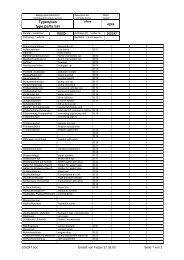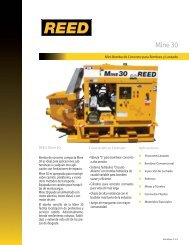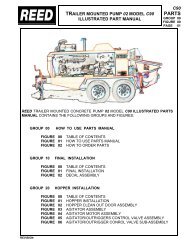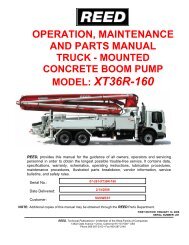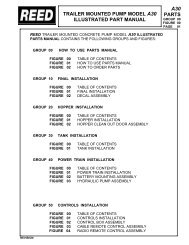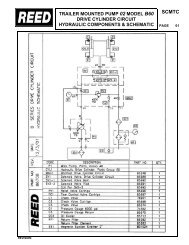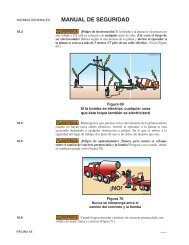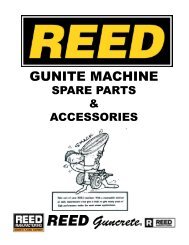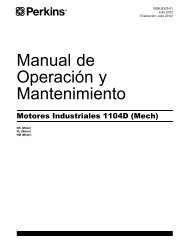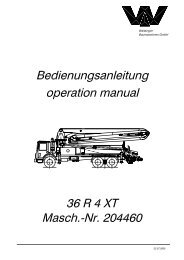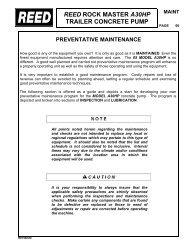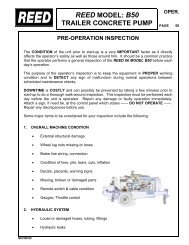Perkins Motor Operation and Maintenance Manual (English) - REED
Perkins Motor Operation and Maintenance Manual (English) - REED
Perkins Motor Operation and Maintenance Manual (English) - REED
You also want an ePaper? Increase the reach of your titles
YUMPU automatically turns print PDFs into web optimized ePapers that Google loves.
SEBU8325-01 35<br />
<strong>Maintenance</strong> Section<br />
Refill Capacities<br />
Some commercial oils that meet the API<br />
classifications may require reduced oil change<br />
intervals. To determine the oil change interval, closely<br />
monitor the condition of the oil <strong>and</strong> perform a wear<br />
metal analysis.<br />
NOTICE<br />
Failuretofollow these oil recommendations can cause<br />
shortened engine service life due to deposits <strong>and</strong>/or<br />
excessive wear.<br />
Total Base Number (TBN) <strong>and</strong> Fuel Sulfur<br />
Levels for Direct Injection (DI) Diesel<br />
Engines<br />
The Total Base Number (TBN) for an oil depends on<br />
the fuel sulfur level. For direct injection engines that<br />
use distillate fuel, the minimum TBN of the new oil<br />
must be ten times the fuel sulfur level. The TBN is<br />
defined by “ASTM D2896”. The minimum TBN of the<br />
oil is 5 regardless of fuel sulfur level. Illustration 18<br />
demonstrates the TBN.<br />
NOTICE<br />
Operating Direct Injection (DI) diesel engines with fuel<br />
sulphur levels over 0.5 percent will require shortened<br />
oil change intervals in order to help maintain adequate<br />
wear protection.<br />
Table 5<br />
Percentage of Sulfur in<br />
the fuel<br />
Lower than 0.5<br />
0.5to1.0<br />
Greater than 1.0<br />
Oil change interval<br />
Normal<br />
0.75 of normal<br />
0.50 of normal<br />
Lubricant Viscosity Recommendations<br />
for Direct Injection (DI) Diesel Engines<br />
The correct SAE viscosity grade of oil is determined<br />
by the minimum ambient temperature during<br />
cold engine start-up, <strong>and</strong> the maximum ambient<br />
temperature during engine operation.<br />
Refer to Table 6 (minimum temperature) in order to<br />
determine the required oil viscosity for starting a cold<br />
engine.<br />
RefertoTable6(maximumtemperature)inorderto<br />
select the oil viscosity for engine operation at the<br />
highest ambient temperature that is anticipated.<br />
Generally, use the highest oil viscosity that is<br />
available to meet the requirement for the temperature<br />
at start-up.<br />
g00799818<br />
Illustration 18<br />
(Y) TBN by “ASTM D2896”<br />
(X) Percentage of fuel sulfur by weight<br />
(1) TBN of new oil<br />
(2) Change the oil when the TBN deteriorates to 50 percent of<br />
the original TBN.<br />
Use the following guidelines for fuel sulfur levels that<br />
exceed 1.5 percent:<br />
• Choose an oil with the highest TBN that meets one<br />
of these classifications: EMA DHD-1 <strong>and</strong> API CH-4.<br />
• Reduce the oil change interval. Base the oil<br />
change interval on the oil analysis. Ensure that the<br />
oil analysis includes the condition of the oil <strong>and</strong> a<br />
wear metal analysis.<br />
Excessivepistondepositscanbeproducedbyanoil<br />
with a high TBN. These deposits can lead to a loss<br />
of control of the oil consumption <strong>and</strong> to the polishing<br />
of the cylinder bore.<br />
Table 6<br />
Engine Oil Viscosity<br />
EMA LRG-1<br />
Ambient Temperature<br />
API CH-4<br />
Viscosity Grade Minimum Maximum<br />
SAE 0W20 −40 °C (−40 °F) 10 °C (50 °F)<br />
SAE 0W30 −40 °C (−40 °F) 30 °C (86 °F)<br />
SAE 0W40 −40 °C (−40 °F) 40 °C (104 °F)<br />
SAE 5W30 −30 °C (−22 °F) 30 °C (86 °F)<br />
SAE 5W40 −30 °C (−22 °F) 40 °C(104°F)<br />
SAE 10W30 −20 °C (−4 °F) 40 °C (104 °F)<br />
SAE 15W40 −10 °C (14 °F) 50 °C (122 °F)<br />
Synthetic Base Stock Oils<br />
Synthetic base oils are acceptable for use in<br />
these engines if these oils meet the performance<br />
requirements that are specified for the engine.



